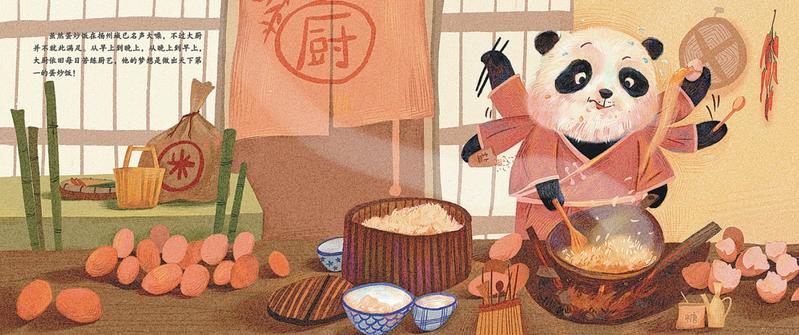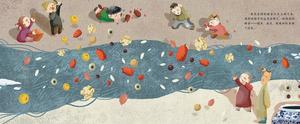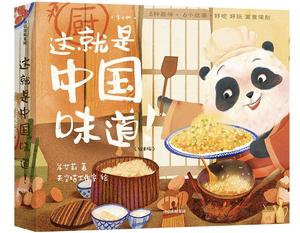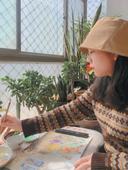A series of picture books gives children and adults a taste of traditional culture by exploring the history and origin of popular Chinese dishes in a new and contemporary way, Mei Jia reports.
 Illustrations from the picture book series This Is Chinese Taste written by Mou Aili and illustrated by a group of young artists. They applied various styles and skills in their illustrations. (PHOTO PROVIDED TO CHINA DAILY)
Illustrations from the picture book series This Is Chinese Taste written by Mou Aili and illustrated by a group of young artists. They applied various styles and skills in their illustrations. (PHOTO PROVIDED TO CHINA DAILY)
As Emeril Lagasse, the US celebrity chef, once noted: "To really get to know a place and its people, you've got to eat the food." Food serves as a key to every culture and, in China, glutinous rice paste, moon cake, spring roll, eight-treasured rice congee, Yangzhou-styled fried rice and dried persimmon are delicacies commonly seen on dinner tables across the country. To Sichuan Fine Arts Institute associate professor Mou Aili, they are her inspiration for a series of picture books that she hopes will "pass Chinese culture and the wisdom it involves on to future generations".
I could associate with the story well, memorizing houses built with mud and bamboo slats back home in the village where I lived as a kid
Long Yuxin, illustrator
Mou is not the first to focus on Chinese food in picture books, which has been a trend in publishing circles over the course of the past decade, especially where food related to a particular custom or certain event, like Spring Festival, is concerned.
Despite the dishes having a rich history in terms of their origins and related tales, Mou is trying something different. By employing new, contemporary storytelling, she turns them into fresh and tasty stories for both younger readers and adults.
The six-volume offering This is Chinese Taste was published with the arrival of this year's Spring Festival. Celebrated illustrator Xiong Liang hails the series for the plot, which combines the traditional with the original, "it does justice to the delicious food, with decent stories," he says.
Mou, as the writer of the six stories, says that, when faced with the vast array of Chinese dishes, she selected around 50 before deciding on a final 18 around which to develop the stories. The first six books will be followed by a further two collections.
 (PHOTO PROVIDED TO CHINA DAILY)
(PHOTO PROVIDED TO CHINA DAILY)
"The composition process is not that easy. Sometimes it goes smoothly and sometimes I found myself stuck, lacking smart and funny ideas, until my mind was lit up by the spark of a thought," Mou says.
She found a breakthrough with setting characters.
In General Da Who Makes Ciba (glutinous rice paste), she depicts a man who is always breaking things because he can't control his unusual strength. He is punished and confined to his home. He steams a pot of glutinous rice and, because of his enhanced brawn, when stirring it, accidentally grinds it into a paste, creating a much loved food.
As his adventure continues, and he joins the army, both he and his strength finds its place.
"This provokes readers to ponder the idea of knowing one's potential and finding the right place to utilize it", Mou says, adding some of the ideas that appear later in the story come from an old tale passed down from the Spring and Autumn Period (770-476 BC).
The image of the adorably clumsy General Da is loved by young students in the schools of Chongqing, the city where Mou works and lives. Before Spring Festival, Mou and the illustrator replicated the image on new year posters for readers to color in.
Mou also tells the story of eight-treasured rice congee as the unification of two villages formerly divided by a river, each of which produces four of the eight ingredients required for the dish-a tale which she says invokes the Chinese worldview of inclusiveness. The mooncake story, however, goes a step further and explores how to "think outside the box", planting the seeds of fantasy in younger minds.
 (PHOTO PROVIDED TO CHINA DAILY)
(PHOTO PROVIDED TO CHINA DAILY)
The moon cake story is written using rhyming couplets that tell of a young boy who tames a monstrous rabbit that lives on the moon with the doughy treats he and fellow villagers make.
Mou, 40, says she often ignored food and regular meal times when she was busy working and teaching before her daughter was born in 2019.
"I suddenly realized that food is the first, and for a while the biggest, connection between a mother and her child," she says. "This is Chinese Taste carries on our cultural heritage and inspires the next generation to tell our stories to a global audience."
Having a bachelor's degree in drama and literature and a PhD in theater and Chinese traditional opera from the Central Academy of Drama, Mou has been teaching for over a decade.
In 2017, Long Yuxin (who is known by her pen name Long Yi), was the university's graduate of year under Mou's instruction.
Long, 27, says she was fan of the teacher's lectures on picture books, though not a picture book major, she attended the lectures over two semesters. Mou is the one who inspired her to be an illustrator, as well as an art educator, in Chongqing.
She is among the six graduates who illustrate the series of books, with each one choosing a different style and technique, including ink and wash, rubbing, cloth collage, watercolor and digital painting.
 Book cover of This Is Chinese Taste. (PHOTO PROVIDED TO CHINA DAILY)
Book cover of This Is Chinese Taste. (PHOTO PROVIDED TO CHINA DAILY)
To bring General Da to life, Long tried different styles and finally decided to combine ink and wash with rubbing prints.
"I could associate with the story well, memorizing houses built with mud and bamboo slats back home in the village where I lived as a kid," she says.
Some of the walls and floors, even mountains in General Da Who Makes Ciba are made from paper tissue prints, creating a pleated pattern.
Mou says the younger generation of illustrators is full of potential, growing up in this new era.
Long says she and her peers feel a strong urge to dig deeper into Chinese culture, while "keeping and developing its unique charms in an age of globalization, with our tone, our experience and our language," she adds.
According to the latest OpenBook data pertaining to the 2020 retail book market that was released in January, under the influence of the COVID-19 pandemic, total retail sales in 2020 dropped by 5.08 percent, after enjoying an average annual increase of around 10 percent between 2015 and 2019. Despite that, children's books and teaching materials, together with Party-themed titles, have kept the dynamic of upward movement in 2020, just at a lower level than the previous year.
Picture books have been prominent in the overall children's book market, especially original titles created by Chinese authors or illustrators.
 Illustrator Long Yuxin works on her illustrations. (PHOTO PROVIDED TO CHINA DAILY)
Illustrator Long Yuxin works on her illustrations. (PHOTO PROVIDED TO CHINA DAILY)
As of 2020, Hong Pi Feng, a sub-brand of China Citic Press specializing in children's books, where Mou's new series is being published, attained a total sales income of 200 million yuan (about $31 million) since its establishment in 2015, and has sold a total of 25 million copies of its books, according to its editors.
Picture book critic Lin Xiaoxi (who goes by the pen name A Jia) says festivals and food have been favorite topics when Chinese creators are seeking inspiration from tradition.
"Like Spring Festival, as the ways to spend the holidays are varied, many creators now are exploring the modern meanings of the festivals, as people don't need them to get new clothes or have big meals anymore," A Jia says.
He offers examples like Nian by Zhu Yinghui, A New Year's Reunion written by Yu Liqiong and illustrated by Zhu Chengliang, and Nian, The New Year Monster by Xiong Liang. All of which won acclaim from an international audience when they were published or exhibited in overseas markets.
And to Mou, picture books mean something more to her: a director's mindset.
Mou says picture books share the same camera language as movies, storyboard skills, action design and more.
"In an era of short videos and livestreaming, our young people are educated mainly within a screenwriter's context, with the focus on written or spoken language alone, which to me is good," Mou says. "However, picture books help train the video director's mindset, and can be started from a very young age."
"They might do better and go further in the time of prevailing video language, aided by the speed of 5G technology."
Contact the writer at meijia@chinadaily.com.cn


